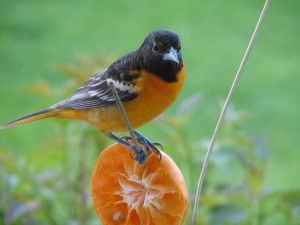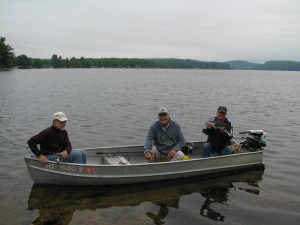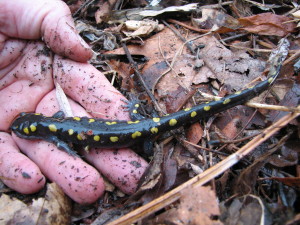by Dana Little March 26th, 2006.
Taylor Pond provides habitat to a great diversity of plants and animals. Birds represent the largest group of vertebrates; I have counted 147 species in the area over the last 6 years, and I consider myself a casual birder. Ninety-three species can be found here during their breeding seasons. Large numbers of birds stop during their spring and fall migrations to and from their northern breeding grounds. On Memorial Day weekend, 2005, I worked at home all weekend, tied to the phone. Every few hours I would go outside to listen and watch the tremendous congregation of birds in my yard. I counted 77 different species of birds that weekend, including15 different species of warblers. Warblers typically live in Central and South America for the winter and travel north to breed. They appear when the leaves start coming out and the black flies can be found in abundance. Some of the more notable breeding species of birds that can be found around the pond include the Wood Duck, Hooded Merganser, American Bittern, Green Heron, Osprey, Bald Eagle, Virginia Rail, American Woodcock, Yellow-billed Cuckoo, Barred Owl, Yellow-bellied Sapsucker, Common Raven, Winter Wren, Rose-breasted Grosbeak, Bobolink, Baltimore Oriole and 8 species of warbler: Yellow, Chestnut-sided, Black-throated Blue, Black-throated Green, Black-and-white, Redstart, Northern Waterthrush and Yellowthroat warblers.
Hang an orange on an old coat hanger and the Baltimore Orioles will come to you.
Because mammals are shy, they are less frequently observed and there are less species of mammals than birds found locally, 19 seen by myself in the last 6 years. They usually travel and feed at night, quickly leaving when the slightest noise is made. Beaver, Muskrat, Chipmunks, Red and Gray Squirrels are common here. Less frequently seen, but still common are the Otter, Mink, White-tailed Deer, Red Fox, Coyote, several species of Bats, moles, voles, shrews and mice.
Taylor Pond has a variety of fish. Biologists have gill-netted 11 different species. There are many smaller species of fish that often migrate in large schools or live in the shadows of the lillypads that have not been identified. The fish most appreciated by the fisherman are the Small-mouth Bass, Chain Pickerel and Yellow Perch. Brook Trout can be found in the small feeder streams. Brown Trout were once stocked and caught years ago; I am not aware of any being caught in recent years.
Successful Bass Fishermen
During spring, the frogs and toads become noticeable with their loud chorus of mating calls. The Wood Frog begins earliest, followed by the Spring Peeper. As the weather warms, Pickerel and Leopard Frogs, Gray Tree Frogs, American Toads, Green and finally Bull Frogs start calling. Two salamanders commonly found are the Yellow-spotted and Red-backed.
Yellow-spotted Salamender
Reptiles tend to find Maine too cold. A few hardy ones are commonly found, including Snapping Turtle, Painted Turtle and rarely the Common Musk Turtle. The Snapping and Painted Turtles often come onto my property and lay eggs. The Garter Snake is the most often spotted snake, rarely the Water and Milk Snakes.
I have not yet mentioned the tremendous variety of plants and invertebrates found in and around the pond. There are thousands of species of plants found locally. I have not found anyone who has cataloged this diversity to its full extent. Protecting Taylor Pond, its water quality as well as the quality of its watershed, protects these plants and animals for future generations to enjoy.
Ice-out occurred this year on March 26th, the earliest I have ever experienced. At a state water conference two years ago a scientist reported that a review of records on ponds in Maine, extending back over a hundred years indicate that ice-out is occurring now earlier than ever. Observations of our natural world, dutifully recorded, reveal issues of global significance. At 239 feet of elevation we will not need to worry about our homes if the oceans rise with global warming. However, the ice fisherman this year had the shortest season in a long time; they barely got their houses off the lake before the ice melted. As I sit writing today, the ducks have taken advantage of the open water; American Merganser, Ring-neck Ducks and Golden-eyes have stopped off in the pond on their way to breed in Canada.


